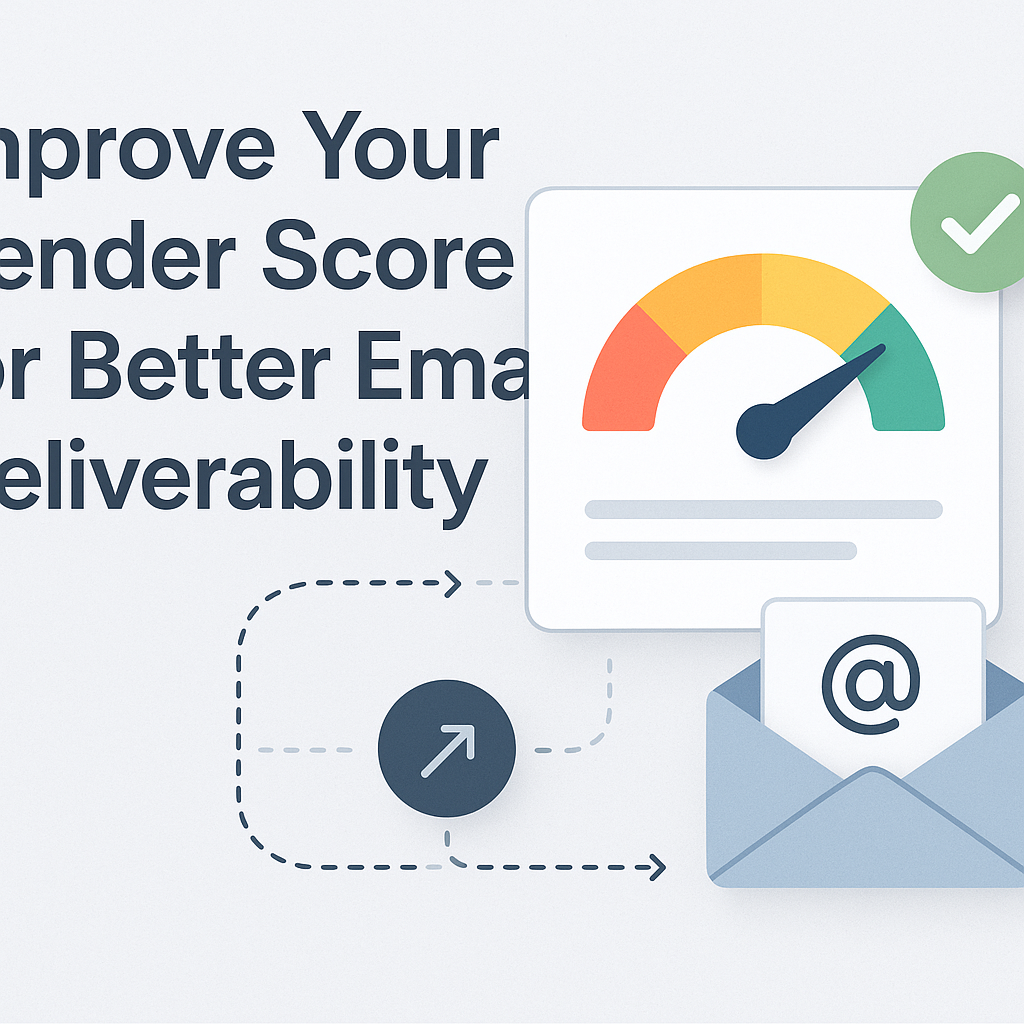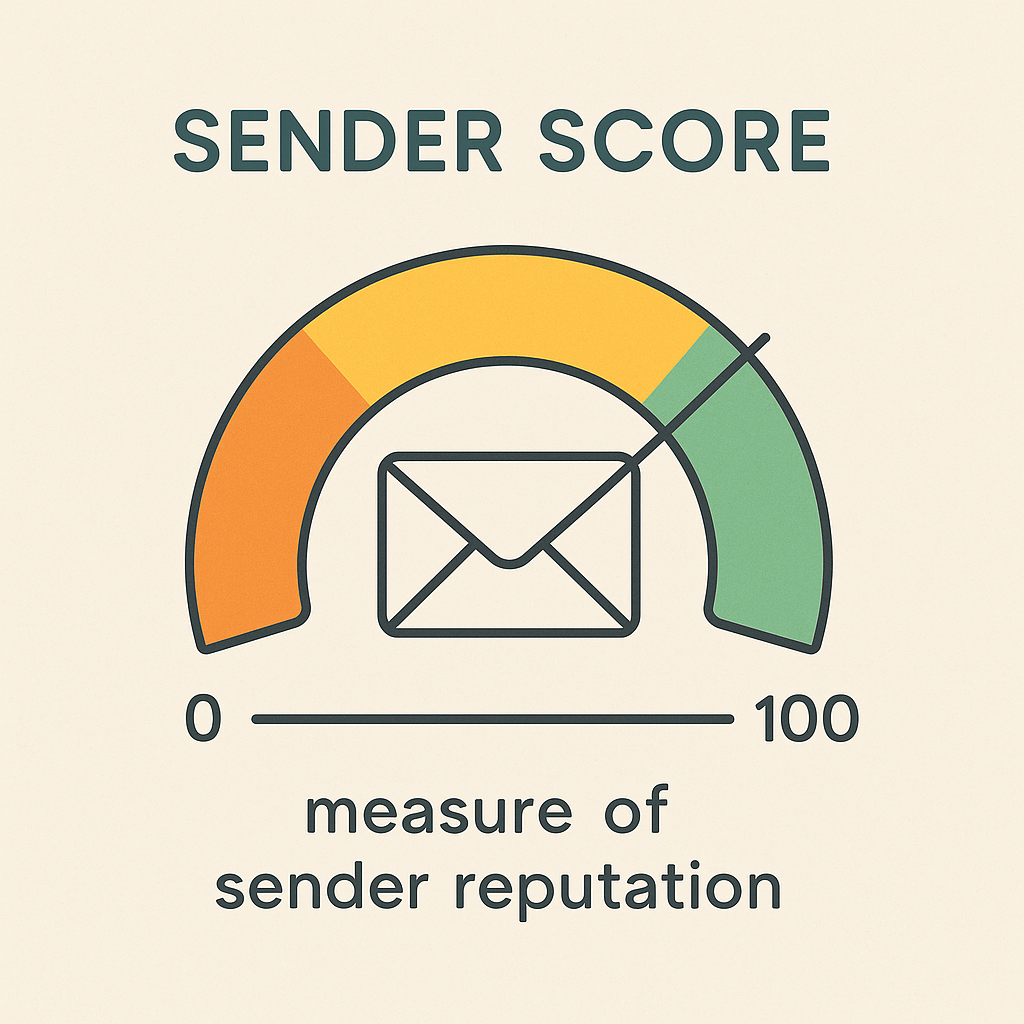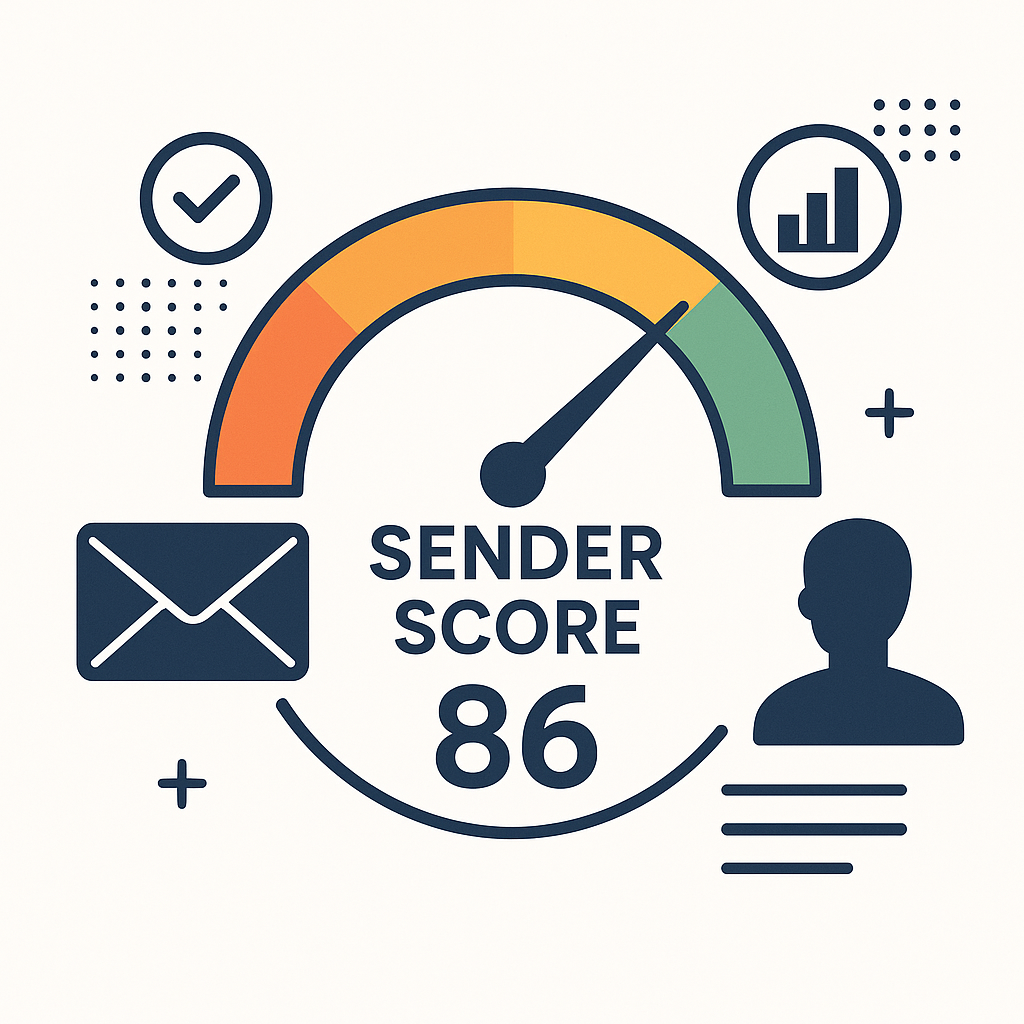Improve Your Sender Score for Better Email Deliverability

In today's digital landscape, the inbox is a battleground. Every email you send is vying for attention, but before it can even compete, it needs to get there. If your emails are consistently landing in the spam folder or being rejected outright, you're not just losing potential customers – you're damaging your brand's ability to communicate effectively. The silent gatekeeper determining your email's fate? Your sender score.
Understanding and actively managing your sender score is no longer a technicality; it's a fundamental pillar of successful email marketing. This score acts as a real-time reputation meter for your email sending practices, influencing whether your messages are welcomed into the inbox or blocked as unwanted spam. For business professionals, entrepreneurs, and marketing teams, a high sender score is synonymous with effective outreach, better engagement, and a healthier return on investment (ROI) for your communication efforts. But what exactly is this score, how is it determined, and most importantly, how can you improve it?
What is a Sender Score and Why it Matters for Email Deliverability
Think of your sender score as your digital fingerprint or credit score for sending emails. It's a numerical representation of your reputation as an email sender, compiled by Internet Service Providers (ISPs) and mailbox providers (like Gmail, Outlook, Yahoo). This score is dynamically calculated based on a complex algorithm that evaluates various aspects of your sending behavior. A higher score indicates to ISPs that you are a legitimate sender who adheres to best practices, making them more likely to deliver your emails to the primary inbox.
Conversely, a low sender score signals potential risk to ISPs. They may interpret it as a sign of spamming, poor list management, or sending unsolicited content, leading them to filter your emails into the spam folder or reject them entirely. This direct impact on email deliverability means that even the most compelling marketing message or crucial business communication can fail if your sender reputation is poor.
The stakes are high:
- Inbox Placement: A good score ensures your emails reach the intended recipient's inbox, not their spam folder.
- Engagement Rates: When emails land in the inbox, subscribers are more likely to open, click, and engage, boosting campaign performance.
- Brand Reputation: Consistent deliverability builds trust and reinforces your brand's legitimacy.
- ROI: Effective email outreach directly translates to leads, sales, and customer retention, maximizing your marketing spend.
How is a Sender Score Calculated? Key Factors and Metrics
While there isn't one single, universally published sender score metric that every ISP uses in precisely the same way, the underlying factors are remarkably consistent across the industry. Providers like Microsoft's Smart Network Data Services (SNDS) and others analyze your sending patterns to build a profile of your trustworthiness. Generally, your email reputation score is influenced by the following key elements:
IP Address Reputation
The IP address from which you send your emails carries its own reputation. If that IP has previously been used for spamming or has a history of poor sending practices, it will negatively impact your score, regardless of your current efforts. This is why dedicated IP addresses are often recommended for businesses with significant sending volumes, allowing you to control and build your own reputation from scratch.
Domain Reputation
Similar to IP reputation, your sending domain (e.g., yourcompany.com) also has a reputation. This is built over time through your sending history and how recipients interact with your emails. A domain associated with legitimate, engaging content will foster a positive reputation.
Engagement Metrics
How recipients interact with your emails is a critical signal. ISPs monitor:
- Open Rates: A healthy open rate suggests recipients find your subject lines compelling.
- Click-Through Rates (CTR): High CTRs indicate that your email content is valuable and engaging.
- Reply Rates: Replies are a strong positive signal of engagement.
- Unsubscribe Rates: While some unsubscribes are normal, a sudden spike can indicate issues with content relevance or sending frequency.
- Spam Complaints: This is one of the most damaging metrics. A high complaint rate is a direct red flag to ISPs that your emails are unwanted.
Bounce Rates
Bounces indicate delivery failures. There are two main types:
- Hard Bounces: Permanent delivery failures, usually due to invalid or non-existent email addresses. High hard bounce rates severely damage your reputation.
- Soft Bounces: Temporary delivery failures, such as full mailboxes or server issues. While less damaging than hard bounces, consistent soft bounces can still signal problems.
List Hygiene and Consent
The quality of your email list is paramount. Sending to purchased lists, outdated lists, or addresses obtained without explicit consent will lead to high bounce rates, low engagement, and increased spam complaints. Maintaining pristine email list hygiene is non-negotiable.
Sending Volume and Consistency
Sudden, massive spikes in sending volume, especially from a new IP address or domain, can trigger spam filters. Conversely, long periods of inactivity followed by a large send can also raise suspicion. Consistent, predictable sending patterns are generally viewed more favorably.
As noted by MailSoar, "The higher the score, the better your e-mail deliverability rate. Be careful, though, as the calculation is based on the last 30 days. This score can therefore change from one emailing campaign to the next." This highlights the dynamic nature of your sender reputation and the need for continuous monitoring and optimization.
The Impact of a Low Sender Score on Your Business (Spam Filters, Rejection, Reputation Damage)
A low sender score is a silent killer of effective communication and marketing campaigns. The consequences ripple through your business, directly impacting your bottom line and brand perception.
Landing in the Spam Folder
This is the most immediate and obvious consequence. When your sender reputation is poor, ISPs assume your emails are unsolicited or unwanted. They will then route your messages to the spam or junk folder, where they are rarely seen, let alone acted upon. This effectively renders your email marketing efforts useless, as your message never reaches its intended audience.
Increased Bounce and Rejection Rates
ISPs may outright reject emails from senders with consistently low scores. This leads to higher bounce rates, which further degrades your sender score in a vicious cycle. High bounce rates signal to ISPs that you are not maintaining your list quality or are sending to invalid addresses, marking you as a risky sender.
Damage to Brand Reputation
Beyond just deliverability, a poor sender reputation can tarnish your brand's image. If your emails are frequently marked as spam by recipients, it suggests that your communication is perceived as intrusive or irrelevant. This can erode trust and make it harder to build genuine relationships with your audience.
Reduced Email Marketing ROI
Every dollar spent on email marketing tools, content creation, and staff time is wasted if the emails don't reach the inbox. A low sender score directly reduces your campaign's effectiveness, leading to fewer leads generated, lower conversion rates, and a significantly diminished ROI. As unspam.email points out, companies that improve their sender scores "enjoy some considerable benefits" that their counterparts without good scores miss out on.
Blocked Sending Infrastructure
In severe cases, persistent poor sending practices can lead to your IP addresses or entire sending domains being blacklisted by major ISPs. Getting off these blacklists can be a lengthy and arduous process, sometimes requiring a complete overhaul of your sending infrastructure and practices.
According to Constant Contact, "Your email sender’s reputation may vary across service providers. Use a tool to check your sender score with each client, and work to maintain a positive score to minimize email deliverability issues." This underscores the need for proactive management and awareness of how different providers perceive your sending behavior.
Actionable Strategies to Improve and Maintain a High Sender Score
Improving your sender score is an ongoing process that requires diligence and adherence to best practices. Here are proven strategies to boost and maintain a stellar sender reputation:
1. Prioritize Email List Hygiene
This is arguably the most critical factor. Regularly cleaning your email list ensures you're only sending to engaged, valid subscribers. Implement rigorous email list hygiene practices:
- Remove Hard Bounces Immediately: Configure your email service provider (ESP) to automatically remove hard-bouncing addresses.
- Manage Soft Bounces: Monitor soft bounces and remove addresses that repeatedly fail to deliver after a few attempts.
- Segment and Clean Inactive Subscribers: Identify subscribers who haven't opened or clicked your emails in a significant period (e.g., 6-12 months). Consider a re-engagement campaign, but if they remain inactive, remove them from your active list. Quality over quantity is key.
- Use Double Opt-In: This confirms subscribers genuinely want to receive your emails, ensuring high-quality sign-ups and reducing the likelihood of complaints or spam traps.
Investing in proper list management, like services that offer business email appending, can help validate and enrich your existing data, further improving list quality.
2. Encourage Engagement and Monitor Feedback
High engagement signals to ISPs that your emails are valuable.
- Send Valuable Content: Ensure your emails are relevant, informative, and provide value to your subscribers.
- Segment Your Audience: Tailor your content to specific segments based on demographics, interests, or past behavior. This increases relevance and engagement, which is crucial for effective lead nurturing strategy.
- Make Unsubscribing Easy: A clear, visible unsubscribe link is essential. Forcing users to jump through hoops to unsubscribe often leads to spam complaints, which are far more damaging to your sender score.
- Monitor Complaint Rates: Regularly check your ESP's feedback loops for spam complaints and investigate the reasons behind them.
3. Authenticate Your Sending Domain
Email authentication protocols help ISPs verify that your emails are legitimate and not spoofed. Ensure you have the following set up correctly:
- SPF (Sender Policy Framework): Specifies which mail servers are authorized to send email on behalf of your domain.
- DKIM (DomainKeys Identified Mail): Adds a digital signature to your emails, allowing receiving servers to verify that the email originated from your domain and hasn't been tampered with.
- DMARC (Domain-based Message Authentication, Reporting & Conformance): Builds upon SPF and DKIM, telling receiving servers what to do with emails that fail authentication (e.g., quarantine or reject) and providing reporting on email traffic.
Implementing these is crucial for building trust and improving your email reputation score.
4. Warm-Up New IP Addresses and Domains
If you're launching a new IP address or domain for email sending, don't start sending large volumes immediately. Gradually increase your sending volume over a period of days or weeks. This allows ISPs to gradually build a reputation for your new sending identity, reducing the risk of being flagged as a spammer due to sudden high activity.
5. Maintain a Consistent Sending Schedule
Avoid erratic sending patterns. Sending a consistent volume of emails at regular intervals helps ISPs understand your sending behavior and build confidence in your legitimacy. Sudden spikes or prolonged silences can raise red flags.
6. Personalize and Segment Your Campaigns
Generic, mass emails are less likely to engage recipients. By personalizing your emails (e.g., using the recipient's name) and segmenting your list to send highly targeted content, you increase the chances of higher open, click, and engagement rates, all of which contribute positively to your sender reputation.
Leveraging AI for Sender Score Optimization and Email Reputation Management
The complexity of managing email deliverability and maintaining a high sender score can be overwhelming. This is where Artificial Intelligence (AI) and advanced automation tools can provide a significant advantage.
AI can analyze vast amounts of data related to your email campaigns, identifying patterns and predicting potential deliverability issues before they impact your sender reputation. For instance, AI can:
- Identify Engagement Trends: AI algorithms can detect subtle shifts in subscriber engagement, flagging segments that are becoming less responsive, allowing you to adjust your strategy proactively.
- Optimize Sending Times: AI can analyze when your subscribers are most likely to engage with emails, helping to schedule sends for maximum impact and better engagement metrics.
- Enhance List Segmentation: AI can help create more sophisticated audience segments based on predicted behavior or interest, leading to more personalized and effective campaigns.
- Automate List Cleaning: AI can power advanced list hygiene tools that go beyond simple bounce detection to identify potentially problematic or unengaged subscribers.
- Predictive Deliverability Analysis: Some AI tools can predict the likelihood of your emails reaching the inbox based on historical data and current ISP policies.
By automating repetitive tasks and providing deeper insights, AI frees up marketing teams to focus on strategy and content. For businesses looking to streamline these complex email management tasks and gain a competitive edge, leveraging tools like an ai executive assistant can be transformative. These platforms can help optimize sending practices, manage lists effectively, and monitor key deliverability metrics, ultimately contributing to a better sender reputation. Embracing an AI email strategy can significantly improve your overall efficiency and ensure your messages are consistently delivered.
Monitoring Your Sender Score: Tools and Best Practices
To effectively manage your sender score, you need to monitor it regularly. While there isn't a single score, various tools and metrics can give you a clear picture of your sender reputation and inbox placement rates.
Key Monitoring Tools
Several platforms offer insights into your sender reputation:
- SenderScore.org: One of the most well-known free tools, it provides a score from 0 to 100 based on data from its network, helping you understand how ISPs perceive your sending reputation.
- GlockApps: Offers detailed inbox placement testing and reputation monitoring across various ISPs.
- ZeroBounce, Kickbox, NeverBounce: Primarily email validation services, these also offer sender reputation monitoring and insights into potential issues.
- Litmus: Provides comprehensive email testing, analytics, and deliverability monitoring tools.
- ISP Specific Tools: For example, Microsoft's Smart Network Data Services (SNDS) provides data on IP reputation for Outlook.com users.
As mentioned by Responsify, using tools like SNDS allows you to "monitor your IP sending reputation, track spam complaint rates, and access other important metrics to gain insights into your email reputation."
Best Practices for Monitoring
- Regularly Check Your Score: Make it a habit to review your sender score and key deliverability metrics at least weekly.
- Analyze Bounce Rates: Differentiate between hard and soft bounces and take action to clean invalid addresses.
- Track Spam Complaint Rates: Keep a close eye on complaints reported through feedback loops. Aim for rates below 0.1%.
- Monitor Open and Click Rates: These are direct indicators of subscriber engagement and content relevance.
- Test Inbox Placement: Use tools to see where your emails are landing across different major ISPs.
- Review Authentication Status: Ensure SPF, DKIM, and DMARC are correctly implemented and functioning.
Common Pitfalls to Avoid When Managing Sender Reputation
Protecting your sender reputation requires avoiding common mistakes that can quickly damage your score and hinder email deliverability:
- Purchasing Email Lists: This is a surefire way to acquire invalid addresses, unengaged subscribers, and people who never opted in, leading to high bounces, complaints, and a plummeting sender score.
- Ignoring Bounce and Complaint Data: Failing to act on bounce notifications and spam complaints is a critical error. These are direct signals of problems that need immediate attention.
- Sudden Sending Spikes: Sending a massive volume of emails without a gradual warm-up period can trigger spam filters and negatively impact your sender reputation.
- Sending Irrelevant Content: If your content doesn't resonate with your audience, they are less likely to engage, more likely to ignore, and may even mark your emails as spam.
- Not Using Email Authentication: Failing to set up SPF, DKIM, and DMARC leaves your emails vulnerable to spoofing and reduces trust with ISPs.
- Infrequent List Cleaning: Letting your email list become stale with inactive or invalid addresses will inevitably lead to poor deliverability.
- Not Segmenting Your Audience: Sending the same message to everyone misses opportunities for personalization and relevance, reducing engagement.
- Lack of Clear Call-to-Actions (CTAs): If subscribers don't know what to do next, engagement suffers.
Conclusion: The Long-Term Benefits of a Healthy Sender Score for Business Growth
Your sender score is far more than just a number; it's a critical indicator of your business's health in the digital communication ecosystem. A high sender score is not just about getting emails delivered; it's about building trust, fostering relationships, and driving measurable business outcomes. By consistently implementing best practices in email list hygiene, content relevance, subscriber engagement, and technical authentication, you invest in the long-term success of your email marketing efforts.
Prioritizing your sender reputation ensures that your messages reach your audience, enabling effective lead nurturing, customer communication, and ultimately, sustained business growth. Treat your sender score as the vital asset it is, monitor it diligently, and leverage the right tools – including smart AI solutions – to maintain optimal email deliverability. The effort you put into nurturing your sender reputation today will pay dividends in customer reach and business growth tomorrow.



